

N I K A I T C H U A T
I X I S A B V I A T
P.O. Box
296, Kotzebue, Alaska 99752
Phone: (907) 442-4160
Fax: (907) 442-4190
Director:
Diane Iglubuq Schaeffer
Email: dvschaeffer@maniilaq.org
|
Used
with permission for educational purposes only.
|
|
LESSON: RESPECT FOR NATURE |
|
November 11, 1999 Group Picture #1
|
 |
 |
|
Winter Group Picture #2
|
Respect for Nature
|
Goals: Students will become familiar with the traditional and modern uses of the resources found on the tundra. Through activities and field trips, students will demonstrate an appreciation for thelife that the tundra provides for our local community. |
 |
 |
|
Akuliaq, Taagruk, and Ivik Kunuyaq perform traditional
Eskimo dance during weekly visit to senior citizen center.
|
Putyuglu Qignaklu.
|
|
Activities: There are many activities that can be used. Listed below are just some of them. Keeping in mind that the tundra provides harvestable fruits and plants for at least a few months, these activities can be adjusted for the type of plants available at the time. Plants that are gathered and preserved would be used during the wintertime as well to remind children of the subsistence routines of the area. |
|
Akuliaq ayahaaq.
|
 |
|
|
|
Anausuk gets help from Aana Taiyaaq on hands-on project.
|
|
Activities:
|
 |
|
Iglubuq
Kavbin
works on an art project.
|
|
Language instruction during activities: These activities provide ample opportunity to use our Native language to describe preschool concepts as well as cultural skills, practices, and family subsistence routines. All of these activities are meant to promote a language-rich environment as well as spark the interest of students and develop other preschool skills. |
Unit
2: Aimmaq
Berry
Picking Buckets
|
Objectives: The student will be able to…
|
 |
|
Berry picking with Abnik.
|
|
Materials:
|
 |
|
Qaayaan v-liuqtuq.
|
|
Teacher Activity
|
Student Activity
|
| Name the student’s color choice in Ieupiaq for them | Choose color of paper that will be used. |
| Make templates that fit the type of container you will be using. | Cut out the template. |
| Assist students through out the activity, letting them know what they are doing in Ieupiaq | Glue the construction paper onto container. |
| Using a hole punch, make a hole in the top of the decorated container | Decorate the container with paper shapes of plants, and markers |
| Show students examples of the plants that they will gather, and explain to them that the aimmaq is what we use to keep berries and plants in while we walk across the tundra. | Feed chenille stem through holes, and twist to make secure handle |
| Gather plants and berries from tundra, and put in container |
|
Assessment:
|
|
|
|
Iglubuq
Kavbin
performs traditional dance for Elders at the senior citizen center.
|
 |
|
Putyuk Nasalik gets help from Aana Taiyaaq preparing
food with ulu for monthly potluck.
|
Unit 3 : Microscope Observations
|
Objectives: The student will be able to…
|
 |
|
Iqagina atikjuk.
|
 |
|
Anausuk ikayuqti.
|
|
Materials:
|
|
Christmas Program 1999
|
|
|
|
Anausuk,
Qaayaan and Iglubuq
Kavbin
perform during annual Christmas program.
|
|
|
|
Akuliaq, Ivik Kunuyaq and Panitchiaq give recital.
|
|
Teacher Activity
|
Student Activity
|
| Describe plants in Ieupiaq for them as they investigate up close using senses of smell, touch. | Help teacher choose the specimens to view. |
| Mount specimens on slides. Some material will sit nicely on a slide without a cover slide. Others would be easier viewed with a cover slide. Adjust the powers accordingly for students if needed. | Assist teacher. |
| Provide art materials for children to describe their view to others with. We found that a large piece of paper, paint, and paintbrushes work fine, and make nice display work later. | Paint their view onto paper. |
| Help children with descriptions by modeling and acknowledging their descriptions. Ask them to share their findings with parents. | Describe some of the memorable features of the plants and insects that they found under the microscope. |
|
Assessment:
|
|
|
|
Uyaana Nauriaqagviliuqtuq.
|
|
|
|
Putuuqti and Abnik
prepare meat for potluck with ulu.
|
|
Objectives: The student will be able to…
|
|
Greg takes Salaktuna, Putuguuluk dog mushing, April
2000.
|
|
|
 |
|
Sliding on hillside after dog mushing.
|
|
Materials:
|
|
Teacher Activity
|
Student Activity
|
|
Review plant names for students. |
Identify parts and types of plants gathered from the tundra. |
|
Review parts of a plant for students. |
|
|
Provide the art materials for students to use for leaf painting, and if needed, an example. |
Use the leaves as paint brushes, and paint a picture with various colors. |
 |
|
Kunuyaq coloring.
|
|
Assessment:
|
 |
|
Putyuk Nasalik, Aviubana,
Ivik Kunuyaq, Putuuqti and Anausuk at play with water station.
|
|
Objectives: The student will be able to…
|
|
Materials
|
|
Teacher Activity
|
Student Activity
|
| Extract berry juices | Describe and identify berries. |
| Provide berry juices, and paper for students. Describe the various berries, their colors with students. | |
| Show students how to make the pictures with the string. Fold paper in half, lay dipped string on folded paper leaving a tail on the outside. Pull string keeping paper folded shut. Open paper. | Follow teacher’s example and directions for making string art. |
|
Assessment:
|
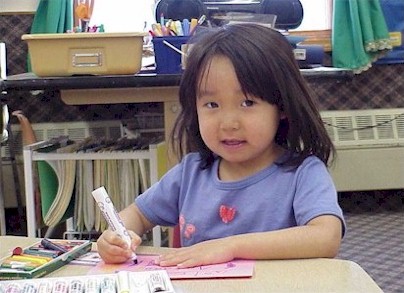 |
|
Siitchiaq minuutiruq.
|
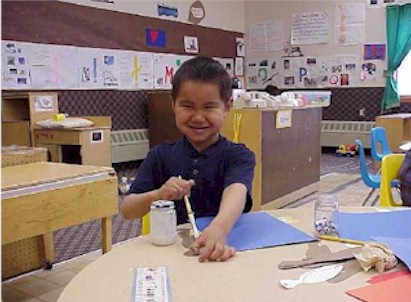 |
|
Taagruk kanayuuraqliuqtuq.
|
Unit
6 : Field Trip
Tundra Walk
|
Objectives: The student will be able to…
|
|
Materials:
|
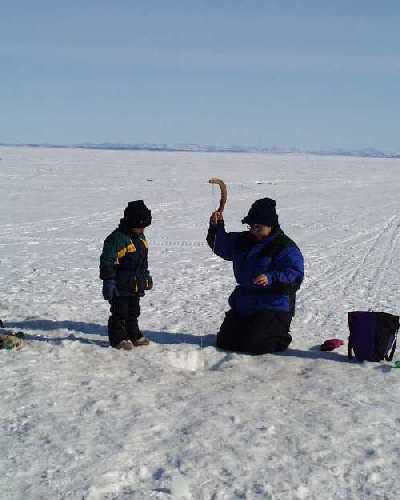 |
|
Frances and son Nuviya hooking.
|
|
Activity: As students explore and gather, explain to students what they are finding, what they can pick, and how to find them on the tundra. |
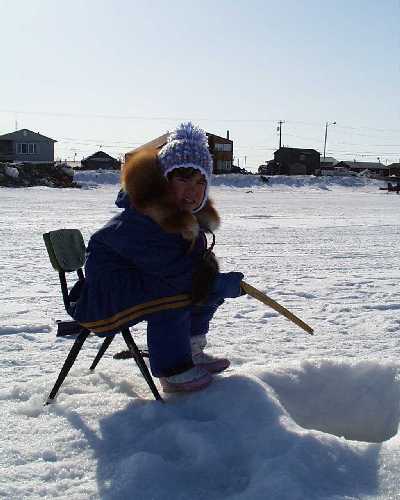 |
|
Putyuk jigging.
|
|
Objectives: The student will be able to…
|
|
Materials:
|
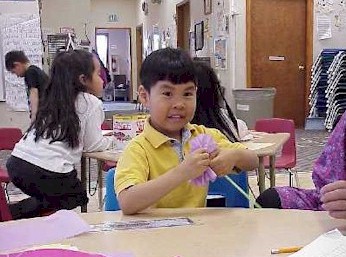 |
|
Kunuyaq nauriaqliuqtuq.
|
|
Teacher Activity
|
Student Activity
|
| Extract berry juices | Describe and identify berries. |
| Before starting, instruct students to make ready by donning their paint smocks, and rolling up their sleeves. | Follow teacher directions. |
| Provide berry juice stamp pads by pouring juice onto a folded paper towel that is sitting on a saucer or small paper plate. This makes a good and inexpensive stamping surface. | |
| Provide cookie cutters, and paper for students. | |
| Describe the various berries, their colors with students. Also help students name the objects on the cookie cutters, their colors, and their respective sizes. | Use Ieupiaq to name to objects they would like to press into the paper. Make the imprints on paper. |
|
Assessment:
|
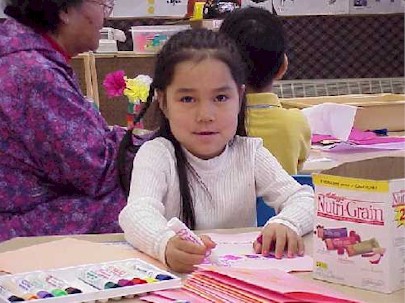 |
|
Agnik munuutiruq.
|
Unit
8 : Aarivak
Insect (Spiders)
|
Objectives: The student will be able to…
|
 |
|
Aviugana killaiyaqtuq.
|
|
Materials:
|
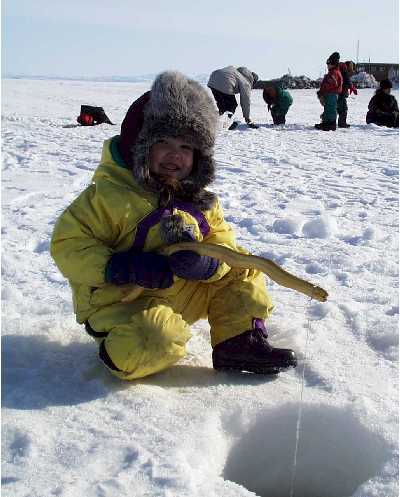 |
|
Qignak, expert jigger.
|
|
Teacher Activity
|
Student Activity
|
| Allow students to look at the insects carefully. Explain respect for animals, and ask them to treat them nicely while examining. If appropriate, allow microscope viewing as well. | Describe and identify insects |
| Sing "Aarivak Mayuqtuq" song with students, teaching motions along with the song. | Sing along and use arm motions "Aarivak Mayuqtuq" |
| Show students sample aarivak and help them to describe color and parts. Assist students with painting the egg carton section inside and out, inserting the chenille stems for legs, and gluing the eyes on the aarivak. Tie a string on for hanging. When hangning, make a pattern for students to notice and describe, (long, short, long, short, or other pattern). | Create aarivak following example and directions of teacher |
|
Assessment:
|
 |
|
Ivik Kunuyaq on a field trip, manaktuq (fishing for
tom cods).
|
|
Objectives: The student will be able to…
|
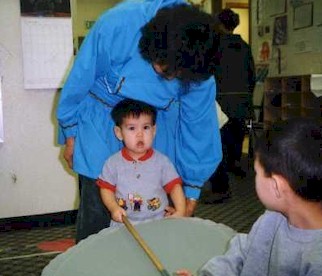 |
|
Qaulluq gets help from his Aana Abnik
before clean up time.
|
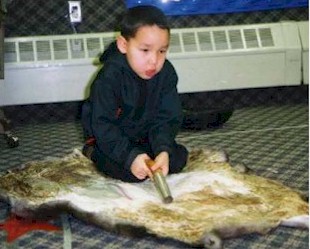 |
|
Akuliaq scraping skin with ikuun.
|
|
Materials:
|
|
Teacher Activity
|
Student Activity
|
| Ask students to examine the plant samples and identify their differences. Lead them to examine the patterns on the leaves, the stems, and the density of the berries on each plant. | Describe and identify berries and their plant parts. |
| Provide students with stem structures for blue berry plants. Using precut construction paper pieces, have them create a collage resembling the sample. If using paint for berries, have them paint berries on. | Glue plant parts onto stem structures paying attention to the pattern of leaves on the stems, and the berries on the plants. |
| Do the same for each type of plant. (This activity may take more than one day). |
|
Assessment:
|
|
|
|
Taagruk, Qaluraq, Akuliaq, Aviubana,
and Ivik Kunuyaq practice traditional singing and drumming.
|
|
|
|
Putuuqti, Uyaana, Taagruk, and Akuliaq perform an
Eskimo dance.
|